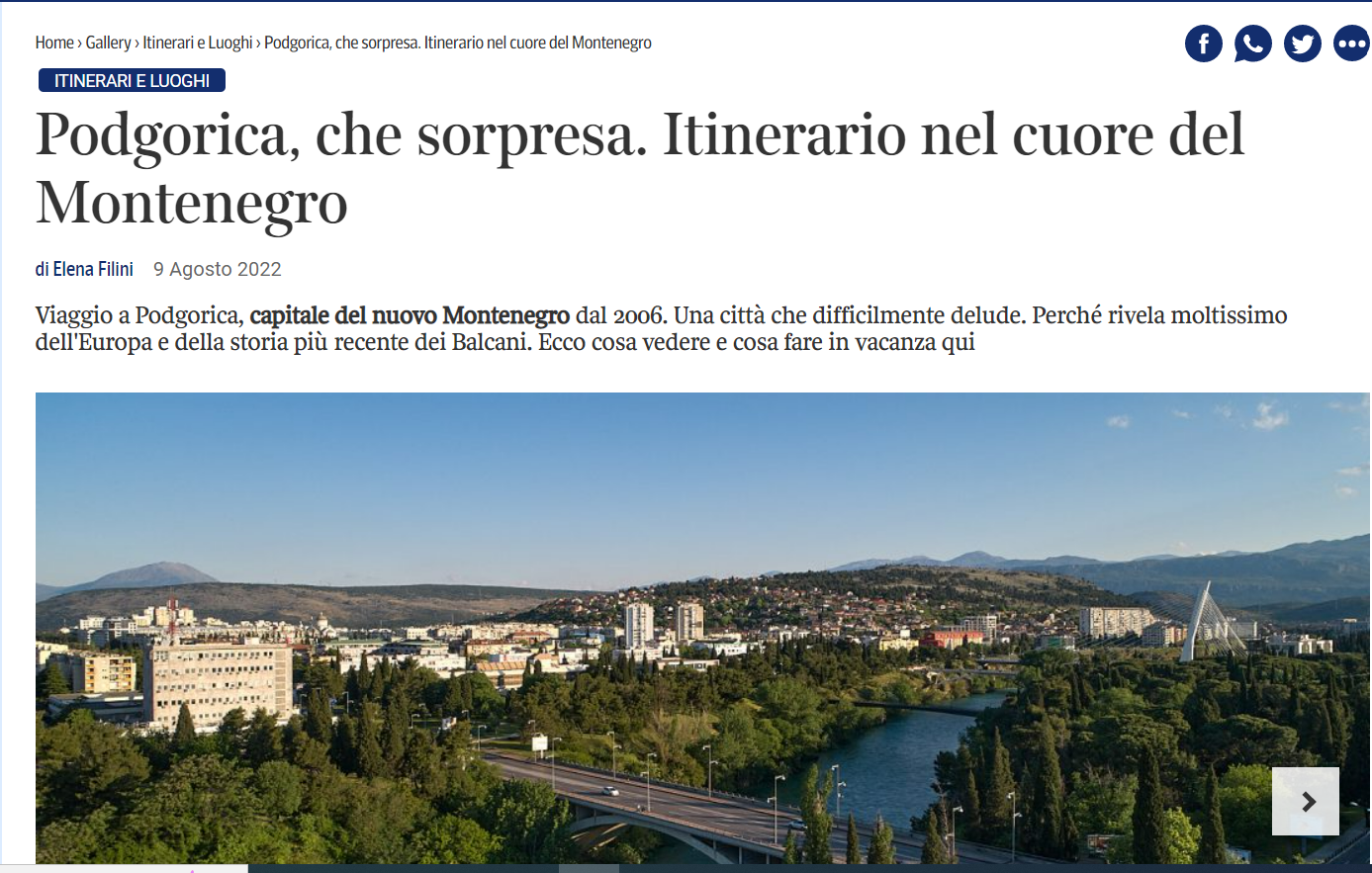
“Podgorica, what a surprise! Itinerary in the heart of Montenegro”
Source: Corierre della Sera ~ Dove Viaggi
“Travel to Podgorica, the capital of the “new” Montenegro since 2006. A city that will hardly disappoint you because it reveals a lot about Europe and the recent history of the Balkans. Here’s what to see and do during your vacation here”.
Podgorica in (late) summer. Experimental journey
There are cities that need to be interpreted. Because only a story can restore the true soul of a place that has been offended by wars and cataclysms. Nothing is more truth when it comes to Podgorica, the former Titograd.
Roman, Ottoman, Pan-Yugoslav, razed to the ground in 1944, hit by a catastrophic earthquake in 1979, and finally the hub and capital of the “new” Montenegro since 2006, this city may not impress you, but it certainly won’t disappoint. Because it reveals a lot about Europe and the recent history of the Balkans.
PODGORICA, JOURNEY THROUGH THE UNDISCOVERED
At the center of the plain of a country composed of 85% rocky mountains, crossed by two rivers with small beaches where you can swim in the center, a place of Ottoman and Orthodox contrasts, dominated by the brutalism of the Titoist era, Podgorica is a small and and well-organized city that you can easily walk around.
The heart of the capital is Independence Square which is located between old, socialist, and new Podgorica, with the modern Millennium Bridge and the Delta shopping center (now called BIG), futuristic buildings and modern cafes.
The river Ribnica (which dries up in summer), separates the eastern area. To the south, there is Stara Varoš, the heart of the Muslim quarter, with some preserved houses from that period and ancient mosques (in which the city administration invests for tourist purposes), and to the north, Nova Varoš, from the twentieth century, with large green areas and some surviving buildings from the end of 19th century.
The Morača River flows westward and connects the city at the characteristic place of Skaline, where ancient bridges and beaches form a true, small oasis in the center of the city.
The whole city is “highlighted” by parks, in summer to moderate the heat, and in winter to prevent the strong north wind. Podgorica has focused a lot on greening, which today makes it one of the five greenest cities in Europe.
WHERE SHOULD WE START OUR VISIT TO PODGORICA?
The starting point is certainly the square with three names (once Ivan Milutinović Square, then the Republic Square and today the Independence Square), dominated by the obelisk dedicated to Mirko Petrović Njegoš, the man who built the pride of Montenegro. From here you go towards Miljana Vukova Street, a former Titoist shopping street that the government wants to reconstruct. At the very corner of the square is Art Gallery & Coffee. Special feature? The cafeteria has a custom space for emerging artists performances.
Continuing along Miljana Vukova Street, you will arrive at the “Museums and Galleries” building, where you can familiarize yourself with the works of the greatest Montenegrin painters like Petar Lubarda and Vojo Stanić.
From here you descend along the Ribnica River and enter one of the most beautiful and hidden areas in the city. The riverbank leads to a building that has lived many lives. It is called “Karver”, a former hammam, converted into a library. An almost imperceptible place, hidden under a modern road that divides the city into two parts: in order to connect them, the Ottoman dome had to be removed.
Carver is a small garrison of Slavic culture: the charm of this bookstore, which is also a publishing house, was given by its owner, actress Varja Đukić
Along the promenade, you reach the old Roman bridge, at the confluence of two rivers. Opposite it there is a hotel “Podgorica”, a true jewel of brutalist architecture, the hotel whose facade is carved with river stones and which was designed by Svetlana Kana Radević in 1967. And right here, in the iconic hotel cafe, you really start to feel Podgorica.
Turkish or deutsch coffee? It’s a slow, relaxing ritual. Coffee lasts here at least two hours, on average :). From Skaline (the epicenter of ancient Podgorica, where there is a Roman bridge with a beautiful view and a favorite beach of the local population), you climb into the Turkish past of the city: low houses, veiled women, small mosques, some isolated and cozy cafes, as well as a mural dedicated to Ksenija Cicvarić, the heroine of Monenegrin song.
Finally, we arrive at Bećir Beg Osmanagić Square, from the Ottoman period, with the Clock Tower in the center, located among the few buildings spared from the catastrophic earthquake on April 15th, 1979.
Finally, Bokeška street, the street of nightlife. On the corner, there is the City Theatre which reflects the rich cultural initiative of the city, such as concerts, operas and operettas. In the center of trendy cafes and clubs, you arrive in front of the City Library, dedicated to Marko Miljanov, advisor to King Nikola (who was educated only at a later age) and return to Independence Square.
Last coffee and fateful question.
WHY IS THIS COUNTRY CALLED MONTENEGRO?
“The name is Venetian” – Ana Žarić, a specialized tourist guide answers.
Coming from Boka Kotorska, Venetian sailors saw this rugged, dark, vertical mountain. It was the mountain Lovćen, the forest where Cetinje, the royal capital of Montenegro, is located. That’s how the name of the inhabitants of the black mountain was born. As then, so today.
INDEPENDENCE SQUARE
Why is the appearance of the main city square different from those we encounter in other large capital cities?
Podgorica won the main role in 2006. Until then, Montenegro formed a union with Serbia, whose capital is Belgrade. In that year, the great revival of the city begins. The square is located in Nova Varoš and covers an area of five square kilometers.
By Western standards, it is a typical example of the Yugo style, and the residents of Podgorica love to spend their afternoons in cafes (in the “Sicilia” bakery, with delicious sweets and excellent espresso), and on special occasions the Independence Square becomes the center of ceremonies and events.
The fountain, the obelisk, the old library and the old buildings tell a lot about the city which, after being destroyed, had to be quickly rebuilt in order to house hundreds of thousands of displaced people.
It is not only the administrative heart of Nova Varoš, but also the best starting point in the city: newer stores mix with less new ones, department stores with socialist overtones coexist with international brands.
PODGORICA MUSEUM
Located in an elegant building, in Marka Miljanova Street, is the main museum of the city. It brings together an interesting collection of archaeological discoveries dating back to the period of ancient Doclea, a city founded by the Romans on a hill (Pod-gorica, the modern name of the capital, which means under the hill). The museum exhibits the works of some of the most important living painters, such as Petar Lubarda, but also the exceptional collection of Božidar Vuković Podgoričanin, the Montenegrin Gutenberg. A beautiful ethnographic section with objects and customs of the Orthodox, Catholic and Muslim communities, which inhabited the country for centuries. In the museum, there are also several buildings where the works of contemporary authors are exhibited (pgmuzej@t-com.me)
CARVER
Perhaps this is the most secret and mystical place in the city. An ancient Turkish bath, hidden under a modern road, has become a bookstore and cafe, a place for cultural gatherings, a publishing house and the seat of a festival dedicated to culture and art.
Founded in 2005, thanks to a European project, this place is the most important scene of the actress Varja Đukić. The actress, academic professor of dramatic arts and one of the leading intellectuals of the city, Đukić gained fame in the Titoist era with the film “Variola Vera”.
“I dreamed of a place that could unite all the cultural souls of the former Yugoslavia, where you can find works of both Western literature and works of all Slavic authors. For this reason, the bookshop is a publishing house but also the organizer of a festival where it gathers the most interesting voices of the Balkans”.
SKALINE, OLD BRIDGE
Hadži Paša’s bridge is located under the ruins of the fortress at the mouth of the Ribnica River into Morača River. It is an oasis of the capital city: in the summer you can swim in the transparent and cold water of Morača, meet fishermen and families at a weekly picnic.
Completely remodeled, the area (today called Skaline, because of the steps carved into the rock) is connected to an old bridge from the Roman period (reminiscent of a miniature of Mostar), rebuilt after the bombing in 1944.
BEĆIR BEG OSMANAGIĆ
In the shade of centuries-old trees, in the center of the square there is a clock tower from 1667, the only ancient building in the city that is still “standing”.
From here we go to visit the Ottoman quarter. Charm is more breathed than seen. There are still some typical Turkish houses, a few mosques, as well as isolated but beautiful cafes.
RISTO STIJOVIĆ HOUSE
In the Ottoman quarter is the house-museum of Risto Stijović, one of the greatest Yugoslav sculptors. Stone and glass, the secret garden and his works, introduce the visitor to the heart of the most significant work of Montenegrin literature, Gorski Vijenac.
“Stijović translated into his wooden sculptures the story of the greatest national poet, bishop Petar Petrović Njegoš, and with this historical work in verse he reconstructs the modern history of Montenegro, starting with the political activity of his predecessor, Danilo Petrović Njegoš, in order to resolve disputes between tribes in the region.” – confirms Selma Đečević, curator of the museum.
KSENIJA CICVARIC
Walking through the old town, attention is drawn to colorful murals. One, before all: the portrait of Ksenija Cicvarić, also known as the Montenegrin nightingale.
Born in a very modest family, growing up on the banks of Ribnica, she managed to give voice to the emotions of a generation and is the mother of the folk song of the twentieth century, in Montenegro. Her most famous song? “Sejdef is the mother of mold”. It is still a hit in national bars. It is known in Montenegro, Serbia and Bosnia, and the author is unknown.
BOKESKA
Cafes and bars in the shadow of the City Theatre, the center of Podgorica’s cultural life. It is Bokeška Street, the core of the city’s night life. A great place for a cocktail after visiting the city, but also a place to better understand the social rituals of this small, developing capital.
DEUTSCH COFFEE
Turkish or espresso? In Podgorica, there is no doubt: it’s Deutsch coffee.
This particular coffee, served in a small cup, is espresso with foam, and it is called that because a few years ago in Montenegro, the currency for payment was the German mark. This coffee cost exactly one mark, hence the name Deutsche coffee.
The currency changed, coffee remained and with it the drinking ritual. Montenegrins always have topics to talk about, they love this ritual that lasts an average of two hours.
LAKE SKADAR
It is impossible to visit Podgorica without stopping at Lake Skadar, the largest lake in the Balkans, on the border of Montenegro and Albania.
A magical place, cruising on old wooden boats that lead to fishing villages and ancient monasteries. A small paradise for birdwatchers and an ideal habitat for many varieties of endangered birds, including rare species of pelicans, cormorants and terns.
The warm waters of the lake, surrounded by olive trees and bamboo, are home to a complex ecosystem with over 800 species of algae and about 50 species of fish.
Many tours depart from Virpazar, a beautiful medieval town located about twenty minutes by car from Podgorica (guided tours cost around 30 euros per person)
FOOD & WINE
Priganice are addictive, with honey and Montenegrin cheese (similar to feta cheese) served for breakfast. The gastronomy of this country is marked by: meat, fish, vegetables in XXL portions.
A traditional gastronomic landmark in Podgorica is the restaurant “Pod Volat”, in front of the Clock Tower.
On the other hand, on Lake Skadar, there is a restaurant “Jezero”, which has just been renovated: choose very fresh river fish. You can buy excellent Montenegrin wines across the street from the restaurant, in the “Plantaže” facility.
Vranac is an autochthonous grape variety, originating from the territory of Podgorica. For those who like bubbles, Val Rosé is perfect, made from Krstač grapes that grow along the shores of Lake Skadar.
USEFUL INFORMATION
Montenegro started the process of joining the European Union in 2013. Current currency is EURO. It is necessary to register within 24 hours from entering the country, otherwise the fine you have to pay is 60 euros. You can get tourist routes, detailed information, organized tours with a guide and more at the offices of the Tourism Organization Podgorica or by email at info@podgorica.travel. “


